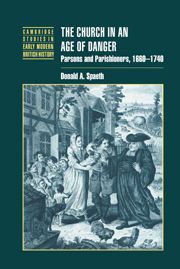Book contents
- Frontmatter
- Contents
- List of tables
- Acknowledgements
- List of abbreviations
- 1 Introduction
- 2 Clerical profiles
- 3 Arenas for conflict
- 4 The management of disputes
- 5 Pastoral care
- 6 Tithes and religious conflict
- 7 The nonconformist threat
- 8 Popular observance
- 9 Matters of life and death
- 10 Singing and religious revival
- 11 Conclusion
- Selected bibliography
- Index
- Cambridge Studies in Early Modern British History
9 - Matters of life and death
Published online by Cambridge University Press: 28 July 2009
- Frontmatter
- Contents
- List of tables
- Acknowledgements
- List of abbreviations
- 1 Introduction
- 2 Clerical profiles
- 3 Arenas for conflict
- 4 The management of disputes
- 5 Pastoral care
- 6 Tithes and religious conflict
- 7 The nonconformist threat
- 8 Popular observance
- 9 Matters of life and death
- 10 Singing and religious revival
- 11 Conclusion
- Selected bibliography
- Index
- Cambridge Studies in Early Modern British History
Summary
Through its liturgy and its clergy the Church of England controlled the major rites of passage: birth, marriage and death. In addition to representing these key stages in the life-cycle of each individual, the ceremonies of baptism, marriage and burial were also important to the broader society. The state insisted that they be recorded in parish registers, and in its search to raise revenue in the 1690s it even taxed them. They were also central to the transmission of property. Participation in the church ceremonies prescribed by the liturgy and in associated secular occasions, such as christening and funeral dinners, served to integrate the community, whose members witnessed the transition of their neighbours through the life-cycle. The use of the liturgical offices was, of course, not voluntary, but they nevertheless played an essential part in popular definitions of the rites of passage. The cleric's role was accepted as indispensable, even in the case of illegal ceremonies such as clandestine marriages. But the clerical role was closely circumscribed, and did not extend beyond liturgical functions.
Churchwardens' presentments at visitations provided the laity with a means of complaining about clerical neglect. Relatively few ministers were presented for their failure to perform baptisms, marriages and funerals or to visit the sick, particularly when compared to the much larger number who were accused of providing inadequate divine service.
- Type
- Chapter
- Information
- The Church in an Age of DangerParsons and Parishioners, 1660–1740, pp. 195 - 224Publisher: Cambridge University PressPrint publication year: 2000



